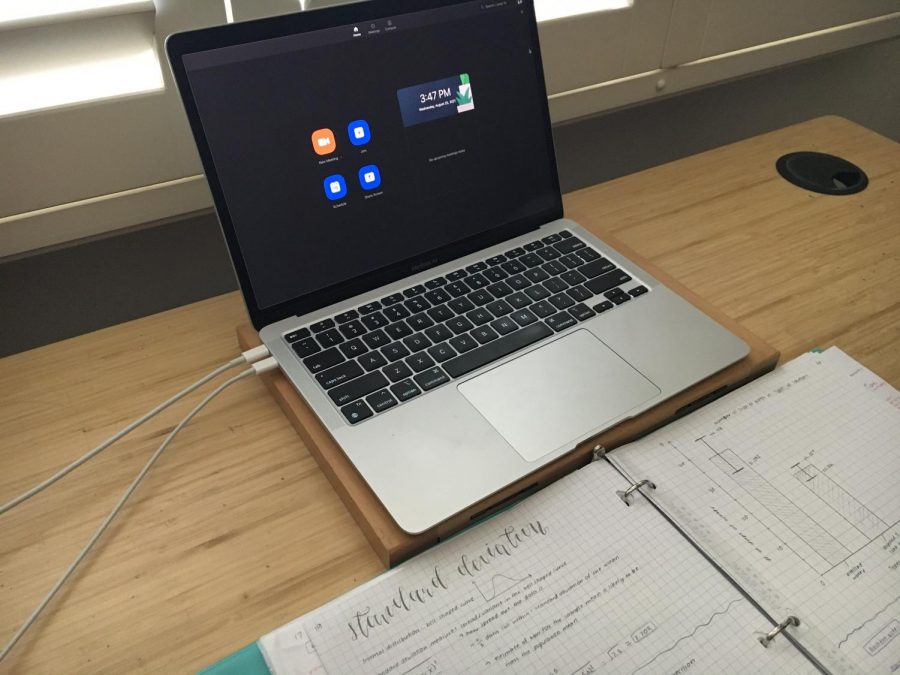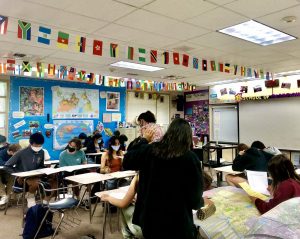Remote learning is our only defense against COVID-19
Taking Zoom classes at home granted students more flexibility in their own schedules and ensured the prevention of spreading COVID-19 to others.
August 26, 2021
Last Wednesday, Amador students all returned to school, donning masks and arming ourselves with bottles of hand sanitizer. However, as the new Delta variant sweeps through Pleasanton and infected cases spike higher still, the best option for Amador students is to revert to online learning once more.
The rising COVID-19 count in Pleasanton answers clearly in the negative. As of August 18, Pleasanton’s cumulative count of coronavirus cases has reached a high of 2814, according to the City of Pleasanton’s COVID Information Center. Since school reopened, Amador families have already been inundated with numerous emails warning of positive COVID-19 infections on campus.
Although over 70% of Alameda County residents have received at least one vaccine dose, the Centers for Disease Control and Prevention has discovered that the Delta variant is more than twice as contagious as previous strains of the virus, and even fully vaccinated people can spread it to others.
With strict mask mandates and social-distancing guidelines in place, students and staff are visibly on edge, adding unnecessary stress to their busy lives. This wouldn’t be the case if we returned back to remote learning.
Online school has offered our students personal solace and convenience that would not have been possible with in-person schooling.
“Being at home is definitely more comfortable – you can relax and use the bathroom whenever you need to,” said Isabelle Lo (‘23).
Attending virtual school on Zoom has also elevated overall student productivity. At home, students were able to learn new material at their own pace, and even develop greater critical thinking skills.
Without teachers present at every second for assistance, students had to take their studies into their own hands to solve problems. This helped many come out of their shell, and become more active participants in class too.
“Raising your hand was easier online than in person, because when you’re in-person you need to commit to raising your arm super high. But then online it was better: you could just click a button and it was less stressful,” said Lo.
Remote learning has also helped teachers discover the wealth of digital tools and platforms available to further guide their students. Teachers have been particularly fond of using Google Classroom for being able to quickly push out documents, readings, and assignments to his classes.
“Technology has allowed me to accordion class time so that everybody can respond to something in a way that wasn’t previously possible due to technology,” said English teacher John Benbenek.
Jonathan Grantham, Amador’s band director, was surprised last year over Zoom at his newfound capacity to connect with so many students simultaneously. He appreciated Zoom’s chat feature, and often used it to seek feedback from students or ask thought-provoking ‘Questions of the Day.’
“Getting to ‘hear’ from every student more often, to hear their words and thoughts, was the most eye-opening thing. It’s weird because in some ways I feel like I got to know more students more personally through the Zoom chat in ways that I did not in-person,” said Grantham.
Naysayers of remote-learning protest Zoom fatigue and exhaustion, but overlook the comedic gold that emerged from a school year spent entirely online.
Creative Zoom backgrounds and filters (think setting your best friend’s face as your green-screen), as well as inadvertent lagging and spontaneous appearances of family members or pets, added long sought-after elements of hilariety to the mundane moments of class.
“I had a girl who was playfully attacked by her dog in the middle of a lecture on camera. It would not stop licking her. That was a lot of fun,” said Benbenek.
Of course, the direct social experiences that come with being in-person are paramount towards student mental and emotional health, yet these exchanges are certainly not irreplaceable and unreplicable — platforms like Snapchat and Discord, for instance, allowed students to foster similarly tight-knit communities and support networks over quarantine.
In consideration of teaching effectiveness, student productivity, and, most importantly, public health and safety, I say yes for Amador to revert back to remote learning.
“We don’t want to get sick,” said Lo.





